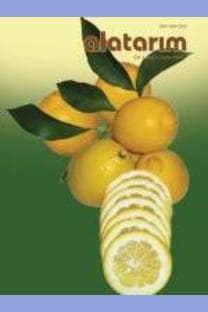Fitofag böceklerin konukçu bitki kabul davranışları
konukçu bitkiler, konuk tercihi, konukçu parazit ilişkileri
Host plant acceptance of phytophagous insects
host plants, host preferences, host parasite relationships,
___
- Bartlet, E., Parsons,D., Williams I.H., Clark, S.J., 1994. The Influence of Glucosinolates and Sugars on Feeding by the Cabbage Stem Flea Beetle, Psylliodes chrysocephala. Entomologia Experimentalis et Applicata 73: 77-83.
- Bartlet, E., 1995. Chemical Cues to Host Plant Selection by Insects Pests of Oilseed RapeAgricultural Zoology Reviews, 7: 89-115.
- Baur, R., Stadler, E., Monde, K., Takasugi, M., 1998. Phytoalexins from Brassica (Crucifera) as Oviposition Stimulants for the Cabbage Root Fly, Delia radicum. Chemoecology 8: 163-168.
- Bernays, E.A., Chapman, R.F., 1994. Host Plant Selection by Phytophgous Insects. Chapman& Hall, 311 pp (95-150).
- Degen, T., Stadler, E., 1998. Oviposition of Carrot Fly (Psila rosa ) in Response to Foliage and Leaf Surface Extracts of Host Plant. Chemoecology, 8 (1998) :39-49.
- Eidenbrode, D.S., Espelie, K.E., 1995. Effects of Plant Epicuticular Lipids on Insect Herbivores. Annu Rev. Entomol, 40: 171-94.
- Gangwere, S.K., M.C., Muralirangan and M. Muralirangan, 1989. Food Selection and Feeding in Acridoids: A Rewiew. Vol (25), No:5, 27syf.
- Griffits, D.W, Deighton,N., Nicolas, A., Birch, E., Patrian, B., Baur, R., Stadler, E., 2001. Identification of Glucosinolates on Leaf Surface of Plants from the Cruciferae and Other Closely Releated Species. Phytochemistry 57 (2001 ): 693-700.
- Kansu, İ.A., Has, A., 1987. Fitofag Böceklerde Konukçu Seçimi. Türk Entomol.Derg., 11(3): 169-183.
- Kroymann, J., Donnerhacke, S., Schnabelrauch, D., Olds, T.M., 2003. Evolutionary Dynamics of an Arobidopsis Insect Resistance Quantitative Trait Locus. PNAS, 100 (2): 14587- 14592.
- Metcalf, R.L., Metcalf, E.R., Metcalf, E.R., 1992. Plant Kairomones in Insect Ecology and Control. Chapman and Hall.168syf.
- Ninkovic, V., Olsson, U., Petterson, J., 2002. Mixing Barley Cutivars Affects Aphid Host Plant Acceptance in Field Experiments. Entomologia Experimentalis et Applicata. 102: 177-182.
- Nielsen, J.K., Hansen, M.L, Agerbirk, N., Petersen, B.L., Halkier, B.A., 2001. Responses of the Flea Beetles Phyllotreta nemorum and P. crucifera to Metabolically Engineered Arabidopsis thaliana with an Altered Glucosinolate Profile. Chemoecology 11:75-83.
- Powell, G.S., Maniar, P., Pickett, J.A., Hardie, J., 1999. Aphid Responses to Non Host Epicuticular Lipids. Entomologia Experimentalis et Applicata 91:115-123.
- Rojas. J.C., Wyatt, T.D., 1999. Role of Visual Cues and Interaction with Odour During the Host Finding Behviour of the Cabbage Moth. Entomologia Experimentlis et Applicata, 91:59-65.
- Schoonhoven, L.M., Jermy, T., Van Loon, J.J.A., 1998. Insect-Plant Biology: Physiology to Evolution. New York : Chapman and Hall
- Smith, C.M., 1989. Plant Resistance to Insects, A Fundamental Approach: “A Waley- Interscience Publication”, 286 p.
- ISSN: 1304-2653
- Yayın Aralığı: 2
- Başlangıç: 2015
- Yayıncı: Alata Bahçe Kültürleri Araştırma Enstitüsü
Çukurova koşullarında turp yetiştiriciliği için elverişli ekim zamanlarının araştırılması
Nebahat SARI, NEZİHE KÖKSAL, Halit YETİŞİR, Hülya ULUTAŞ
Aşılı fide kullanımının sera kavun yetiştiriciliğinde beslenme durumuna etkisi
Fuyu ve Harbiye Trabzon hurması çeşitlerinde kalite kayıpları ve önleme yolları
Ahmet Erhan ÖZDEMİR, Elif ERTÜRK, CELİL TOPLU, Mustafa KAPLANKIRAN, ERCAN YILDIZ
Bazı sofralık üzüm çeşitlerinin fenolojik dönemleri ile salkım ve tane özelliklerinin saptanması
GÜLTEKİN ÖZDEMİR, SEMİH TANGOLAR, HATİCE BİLİR EKBİÇ
Anamur yöresindeki muz seralarının yapısal ve işlevsel özellikleri
Cengiz TÜRKAY, H. Hüseyin ÖZTÜRK, Hasan PINAR, M. Murat HOCAGİL
Dünyada son yıllarda yürütülen asma ıslahı çalışmalarının hedefleri ve kullanılan ıslah yöntemleri
Fitofag böceklerin konukçu bitki kabul davranışları
